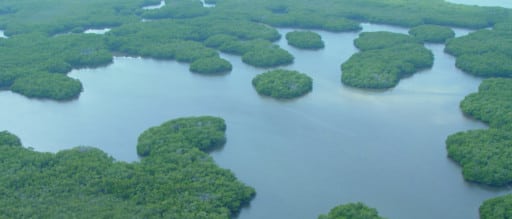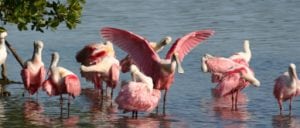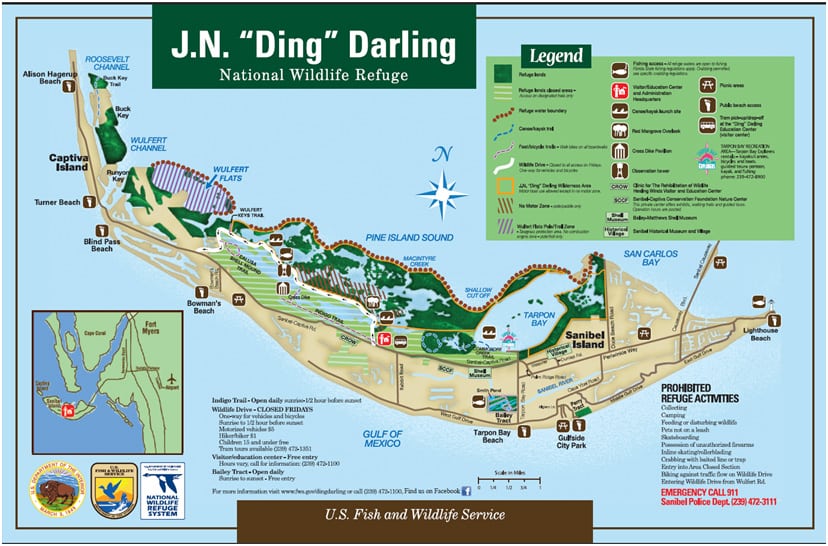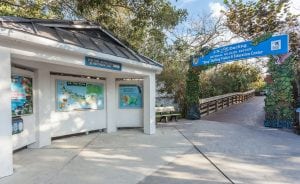J.N. Ding Darling National Wildlife Refuge
Sanibel Island is home to a national treasure – the J.N. Ding Darling National Wildlife Refuge. Named for the pioneer conservationist, Jay Norwood ‘Ding’ Darling, the area is over 6,400 acres in size. The uniqueness of the area is that it is an undeveloped mangrove forest, full of cordgrass, seagrass beds and marshes. Darling could see the importance of keeping this pristine place as a wildlife habitat and resting, nesting place for migratory birds. In 1945 it was made a national wildlife refuge.

Aerial view of Ding Darling. Photo credit fws.gov
Birding at J.N. Ding Darling

Photo credit fws.gov
Visitors to Florida can come and experience the refuge year-round. Your family can bring the checklist and look for over 245 species of birds in the tangled roots of the mangroves. The American White Pelican, the Mangrove Cuckoo, the Reddish Egret, the Roseate Spoonbill and the Yellow-crowned Night Heron all abide in the safety of this protected habitat. These birds are the ‘BIG 5’- the ones avid bird-watchers want to see. However, there are many other spectacular birds that live or visit the area, especially in the winter months. Watch with your children as White Ibis and American Flamingos wade through the waters in search of food. Listen to the Common Loon’s winsome call. You may even spot a Bald Eagle clutching a freshly caught fish.
Ding Darling is called a birding hotspot due to the abundant number of different bird varieties in the refuge. Here is a short video that highlights what to expect:
Mammal Spotting
If you can plan your visit in the early morning or late evening hours you may catch a glimpse of a bobcat. They are night hunters, rarely seen during the daytime hours. Other mammals in the refuge include Marsh Rabbits, Sanibel Island Rice Rats, and even River Otters.
Reptiles
In the marshes, throughout the waters, or basking on logs are American Alligators and Ornate Diamondback Terrapins. Gopher Tortoise, Yellow Rat Snakes and Mangrove Salt Marsh Snakes all help to keep the rodent and insect populations under control. Lizards like the Southeastern Five-lined Skink and the Green Anole round out the reptiles in the J.N. Ding Darling National Wildlife Refuge.
Endangered Species
Florida is home to a number of endangered species and the refuge hosts many of them including the West Indian Manatee. These gentle creatures eat aquatic vegetation and love the warm waters and safety of the mangroves. Smalltooth Sawfish, Loggerhead Turtles, and Wood Storks – all endangered species, find safety in the island refuge.
Get Moving
Of course, maybe you and your family want to do something besides bird and animal-watching. There are plenty of activities in the refuge for families or individuals to enjoy. Hike, bike or drive through the area. Bring your kayaks or canoes and launch into the waters for a day of fun. You could also grab your rods and reels and try to catch snook or spotted sea trouts.
There are three main trails you can follow when hiking or biking – Indigo Trail, Shellmound Trail and Wulfert Keys Trail. The Indigo Trail is short and offers a boardwalk over the water with a viewing platform. The Bailey Tract is open for hikers and bikers only. Here the interior wetlands hold lots of freshwater plants and the animals that live in and around the watery areas.
Take a Tour
There is a tram that takes visitors through the J.N. Ding Darling National Wildlife Refuge. This is perfect for those with mobility issues. The tour is narrated and fun. There is also a gift shop that sells t-shirts, nature books, post-cards and magnets. There is also an educational center that has displays and interactive exhibits, including a hands-on area for the kids. This center is free to the public.
See You Soon
 Sanibel Island, Florida has plenty to offer visitors including lovely beaches, picnic areas and a shell museum. Come and experience the relaxed feel of nature, island time, and soft sands on your next visit here. For hours and admission information to the J.N. Ding Darling National Wildlife Refuge, visit their website or call 239.472.1100. For more information on nature conservation in the refuge, visit the dingdarlingsociety.org.
Sanibel Island, Florida has plenty to offer visitors including lovely beaches, picnic areas and a shell museum. Come and experience the relaxed feel of nature, island time, and soft sands on your next visit here. For hours and admission information to the J.N. Ding Darling National Wildlife Refuge, visit their website or call 239.472.1100. For more information on nature conservation in the refuge, visit the dingdarlingsociety.org.

